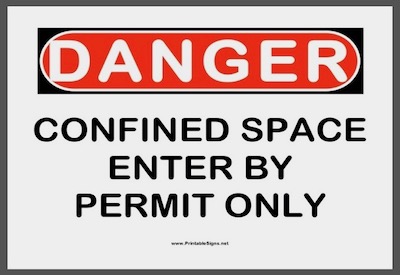12 Tips on Working Safely in Confined Spaces During the Pandemic

May 9, 2021
Working in confined spaces during the pandemic adds a new dimension of risk to a high-stakes activity. These workers already face possible exposure to toxic substances, shock and electrocution, explosions, asphyxiation, and other hazards.
If something goes wrong, the consequences for these workers and their rescuers are often greater than in regular workspaces. An estimated 60% of fatalities involve would-be rescuers.[1]
Throughout the pandemic, Chad Kavanaugh, a confined space expert with Workplace Safety & Prevention Services (WSPS), has been helping workplaces ensure confined space work proceeds safely. EIN reached out to Chad for tips on what these workplaces need to know and do. But first, a study of confined space fatalities conducted by Quebec’s Institut de recherche Robert-Sauvé en santé et sécurité du travail (IRSST) offers insights on where workplaces go wrong. These workplaces
• did a poor job of identifying hazards and estimating risks
• failed to perform a risk analysis in advance of the operation
• improvised rather than planned confined space operations
• did not ensure that workers followed a work procedure
• did not have rescue plans available[2]
How you can prevent incidents
Start with this guiding principle: you have to control the hazards before workers enter the confined space. Otherwise, it may be too late.
Chad offers these five suggestions for prepping for work in a confined space:
1. Identify all confined spaces. “Some workplaces may not realize they have confined spaces,” says Chad. Here are examples of fully or partially enclosed spaces: electrical vaults, robot cells, vats, tanks, pits, grease traps, silos, and in-floor process pits.
2. Understand what’s required by law to maintain an effective confined space management program. Aim to exceed minimum requirements.
3. Before workers enter a confined space, conduct a comprehensive risk assessment, taking into account the physical characteristics of the space (e.g. dimensions, location of entry and exit portals), actual and potential hazards (e.g. uncontrolled energy, moving equipment, space contents; atmospheric conditions; physical, biological, ergonomic and psychosocial hazards), and rescue considerations, including external conditions or activities that may affect what’s going on inside.
4. Assign a “competent” person to conduct the assessment as defined by occupational health and safety legislation — someone with the knowledge, skills and experience to do the work. If you don’t have a competent person on staff, bring in an outside expert.
5. Plan the work and work the plan. “Don’t rely on generic procedures,” says Chad. “Instead, look at each space on a case-by-case basis. Practice entering, performing the work, exiting, and rescuing workers to ensure you have the work processes and equipment in place to complete the task safely.” If something were to go wrong, would you be able to rescue workers swiftly?
Add these COVID-19 considerations to your preparations
Take COVID-19 precautions into account when conducting the hazard assessment and planning the work. For example:
6. Assess workers’ health before they enter the space (e.g. temperature test, self-assessment, rapid COVID-19 antigen test if available).
7. Minimize the number of workers in the space so long as the work can be performed safely.
8. Increase ventilation if appropriate.
9. Implement ways to maintain physical distancing if atmospheric conditions do not call for respiratory protection; if possible, mark off 2-metre workspaces and employ a one-way traffic system.
10. If physical distancing is not possible, ensure workers wear masks or face coverings; provide eyewear to protect against aerosols.
11. Avoid sharing equipment, especially PPE. Deep clean any respiratory protection equipment before reuse.
12. Disinfect tools and equipment after the work has finished. Refer to Health Canada’s list of approved disinfectants. Warning: 3M cautions against using disinfectants on porous, synthetic components of fall-arrest equipment.[3]
This article was reprinted and adapted for EIN with permission from Workplace Safety & Prevention Services (WSPS), a health and safety association serving Ontario’s manufacturing, agricultural and service sectors. Many WSPS safety resources are pertinent to workplaces in other Canadian jurisdictions; https://www.wsps.ca.
References
1. Canadian Centre for Occupational Health and Safety; www.ccohs.ca/oshanswers/hsprograms/confinedspace_intro.html
2. Development of a Confined Space Risk Analysis and Work Categorization Tool, IRSST, p. 30; www.irsst.qc.ca/media/documents/PubIRSST/R-955.pdf?v=2021-02-05
3. In its warning, 3M states that “many webbing and stitching elements are extremely porous and when exposed to chemicals found in many disinfectants may degrade and ultimately affect the product’s original design and strength requirements.” Instead, 3M offers alternative cleaning guidelines.
Photo source: Printable Signs; www.printablesigns.net/preview/Danger_Confined_Space

















